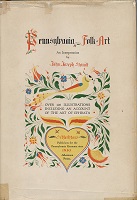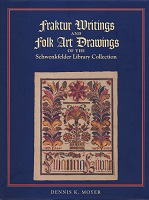Are fraktur motifs symbolic? This topic is one of the most contentious and difficult to interpret in the field. One instinctively searches for hidden meaning in the rich iconography of fraktur. After all, since many motifs are repeated, they may tie to continuing threads in the culture of the Pennsylvania Germans. Certainly, the commentary on place mats in many tourist restaurants take that position!
 The symbolist approach is proclaimed by John Joseph Stoudt in a series of books (Stoudt, 1937, 1948, 1966). Stoudt explains that fraktur is “a folk art that derives from…a community of conception…common fund of ideas, images and general iconography” (Stoudt, 1966, p. 7). Specifically, “the motifs and designs of the folk art of eastern Pennsylvania are non-representative expressions of traditional Christian imagery portrayed in a style which is characteristic of and indigenous to Pennsylvania’s religious groups” (Stoudt, 1966, p. 5). His thesis is that this style derives from historic Pietistic and mystical beliefs introduced centuries before.
The symbolist approach is proclaimed by John Joseph Stoudt in a series of books (Stoudt, 1937, 1948, 1966). Stoudt explains that fraktur is “a folk art that derives from…a community of conception…common fund of ideas, images and general iconography” (Stoudt, 1966, p. 7). Specifically, “the motifs and designs of the folk art of eastern Pennsylvania are non-representative expressions of traditional Christian imagery portrayed in a style which is characteristic of and indigenous to Pennsylvania’s religious groups” (Stoudt, 1966, p. 5). His thesis is that this style derives from historic Pietistic and mystical beliefs introduced centuries before.
Stoudt leverages this proposition to lend intellectual coherence to and bolster the cultural significance of Pennsylvania German culture. For example, “the Pennsylvania German dream was of the mystical Lily that blooms in all ends of the earth. Around the dream a colony was built.” He sometimes goes on to hyperbolic competition with the supposedly inflated standing of New England in historical scholarship. “The full blown rose of mystical transcendentalism blossomed in Pennsylvania a full century before New England’s scrawny plant began to bud” (Stoudt, 1966, p. xix). Stoudt finds context for the Pennsylvania German attraction to allegory and symbolism in Jung’s theory of the connection between archetypes of the psyche and the graphic arts (Stoudt, 1966, p. 123).
 Standing against Stoudt’s symbolist stance is Pastor Frederick Weiser, who describes the Taufschein as “a record and reminder of the sacrament’s meaning, a natural repository for further information about the individual and his family…the objects depicted suggest occupations, avocations and the free play of the artist’s imagination rather than religious profession” (Weiser, Piety and protocol, 1974, p. 43). For Weiser, the wide variety of designs on the Taufschein indicates that Fraktur decoration was an object of design for its own sake. In sum, “…looking too deeply for meaning in a Fraktur pomegranate is as fruitful as analyzing why owls and turtles have center stage on your cocktail napkins and guest towels” (Weiser, Fraktur, 1973, p. 6).
Standing against Stoudt’s symbolist stance is Pastor Frederick Weiser, who describes the Taufschein as “a record and reminder of the sacrament’s meaning, a natural repository for further information about the individual and his family…the objects depicted suggest occupations, avocations and the free play of the artist’s imagination rather than religious profession” (Weiser, Piety and protocol, 1974, p. 43). For Weiser, the wide variety of designs on the Taufschein indicates that Fraktur decoration was an object of design for its own sake. In sum, “…looking too deeply for meaning in a Fraktur pomegranate is as fruitful as analyzing why owls and turtles have center stage on your cocktail napkins and guest towels” (Weiser, Fraktur, 1973, p. 6).
Pastor Weiser explores the meaning of fraktur texts even as he challenges the symbolic role of the accompanying decoration. The message of the texts is the religious philosophy of the Pennsylvania Germans and that which is revealed is, not surprisingly, entirely consistent with other sources about their views (Weiser, Piety and Protocol, 1974, pp 35, 36).
Thus, we have contradictory interpretations claiming either that fraktur artists drew symbolically meaningful iconography or that they repeated inherited decorative motifs or drew whatever moved them.
 Other authors deal with the dilemma in various ways. Moyer likens the spread of fraktur style to the old game, whisper down the lane. That is, basic themes were passed on and changed according to the listener’s interpretation (Moyer, 1998, p. 3). Yoder thoroughly explores the spirituality expressed in fraktur and confirms the influence of Pietism through close and thoughtful reading of accompanying texts. Shelley takes the middle ground by denying both the theories of Pietistic symbolism and simple decorative embellishment. He points out that the vast preponderance of fraktur embellishment is floral decoration, related to the hymnology of the Pennsylvania Germans, which uses largely floral metaphors. Fraktur decoration, to him, is inspired by hymnology rather than expressive of shared belief in precise meanings of symbolic objects (Shelley, 1966, p. 84).
Other authors deal with the dilemma in various ways. Moyer likens the spread of fraktur style to the old game, whisper down the lane. That is, basic themes were passed on and changed according to the listener’s interpretation (Moyer, 1998, p. 3). Yoder thoroughly explores the spirituality expressed in fraktur and confirms the influence of Pietism through close and thoughtful reading of accompanying texts. Shelley takes the middle ground by denying both the theories of Pietistic symbolism and simple decorative embellishment. He points out that the vast preponderance of fraktur embellishment is floral decoration, related to the hymnology of the Pennsylvania Germans, which uses largely floral metaphors. Fraktur decoration, to him, is inspired by hymnology rather than expressive of shared belief in precise meanings of symbolic objects (Shelley, 1966, p. 84).
Amidst the contradictory positions, one notable fact is that the debate takes little heed of the extensive literature on art and iconography in Europe at the time that the antecedents of fraktur folk art were being practiced. Cursory exploration of that field seems to indicate a very strong tradition of emblematic messaging in the art of the time. Purely representational art was only very gradually coming into prominence. This gives credence to the symbolist school of thought or some variance of it.
In addition, we should distinguish between the initiators of Pietistic iconography essential to the Pennsylvania German world view and those who later followed already established folk norms. Thus, the truth may be a confusing mix of symbolist interpretation of worldview followed by work within established folk tradition.
1,587 thoughts on “Is Fraktur Symbolic?”
Comments are closed.